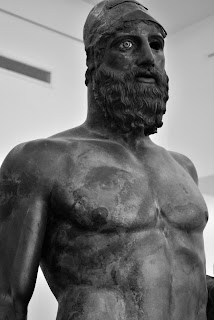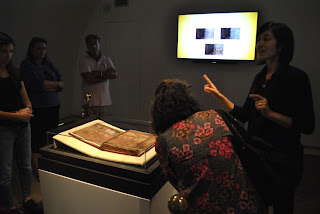
Thursday 28 July, I started a journey through Calabria and Sicily.
I came back Sunday 7 August, after having spent almost two weeks travelling around by my city car (800 cc), and covered almost 2000 kilometres.
Frankly, I was sick and tired to eat pizza and sleep in cheap B&B every night.
So, I'm very glad to be at home now, writing a new article on my blog.

Today, I'm going to report about Calabria, a land wonderfully portrayed by one of his son, Corrado Alvaro (pictured).
At the archaeological museum of Reggio Calabria, I came across Cristina Versaci, journalist of Calabriapost for which she edits the section Calabria IGnota.

We have chance to talk about Corrado Alvaro, and Cristina says "I highly suggest you to read the Alvaro's cult book Gente d'Aspromonte"
However, let's start from the very beginning.
Lucia and I, leave Altamura early in the morning. I drive towards Taranto, then I take the SS 106, la ionica, which runs along the Ionian sea.
We are heading to Rossano, a town mostly known for two reasons: licorice and and codex purpureus.
The codex is exhibited at the Museo Diocesano of Rossano.
If you consider yourself a bibliophile, then you can't miss the codex.
But what is the codex and why is so important?
The codex is a Byzantine illuminated book, the oldest in the world.
Researchers believe that it has been made in Antiochia (Syria) between 5th and 6th century AC.
It's written in silver and gold, moreover, it contains 15 illumination tables.
Scientists hypothesise that the codex belonged to the Byzantine court. Then, brought to Rossano by monks who escaped from Costantinopoli because persecuted during the iconoclastic war.
When I enter the Museo Diocesano, we are welcomed by Grazia, whom I met years ago in Manfredonia as she got married with Mario, an old friend of mine.

 Grazia leads us to the ancient world evoked by the miniatures.
Grazia leads us to the ancient world evoked by the miniatures.It's often said that Byzantine art is static.
As you can see, the illuminations show right the opposite.
"In 1879, two Germans scientists, Adolf Von Harnack and Oscar Von Gebhardt, revealed to the world the importance of the codex" Grazia says.
She continues "They even attempted to purchase it offering to the bishop a huge amount of money. It didn't work, though".
Enchanted by this priceless book, we leave the museo Diocesano to walk around Rossano Alta.

We head to the Byzantine church of San Marco (10th century).

The Greek-Byzantine rite has remained in place in Rossano till 1460, when the new bishop replaced it with the Latin-Catholic one.
Finally, at 8 pm, we end up at La Bizantina, a restaurant where you eat local and well for little money.
The day after we have a quick breakfast. Then, we leave Rossano alta for Rossano bassa in order to visit the Amarelli museum.

Amarelli is a company which sells pure licorice collected in Calabria.
Amarelli family was in Rossano since around 11th century.
Amarelli starts producing licorice only starting from 18th century.
Indeed, before Amarelli and other companies realised the properties of licorice (which Chinese were already aware of), local farmers detested it because of its roots, so long, so difficult to eradicate.
Indeed, they were called the "hell roots".
We leave Amarelli not before having bought a bag of licorice.
At midday, we resume our journey.
We pass by Sibari, one of the most important Greek colonies during the Magna Graecia times.
So, we stop there and visit the Archaeological museum.
While walking throughout the car park, we notice an old fashion car used by archaeologists ages ago, abandoned there.

It seems to me the right place to abandon such car.
Sibari as well as Kroton (currently Crotone) were Achaean settlements.
However, a war erupted in 510 AC between Sibari and Kroton, apparently because Kroton despised the dolce vita carried out by Sibariti.
According to Diodoro Siculo, Crotoniati won the war led by their most famous son, Milo, a wrestler who had won 7 times the Olimpic games.
After having admired the museum of Sibari, we cannot avoid to visit the Archaeological museum of Kroton.
Therefore, we get on our city car and drive towards Crotone.
The city centre of Crotone is interesting.
While walking towards the museum, I notice a bunch of people standing, aligned outside a ground floor.
After a while I realise that they are muslims who are actually praying.
I respectfully move away.
The archaeological museum of Crotone shows some fantastics objects.
Kroton was important at the time not only for its great athletes, but also because it hosted the most important temple dedicated to Hera Lacinia, the Zeus' wife.

The temple is located at capo Colonna, few km far from Crotone.
At that times, everyone who sailed by Kroton could contemplate the biggest temple dedicated to Hera in the whole western Magna Graecia.
The museum of Crotone hosts golden crown which adorned the head of Hera.
Then, there is another interesting piece which represents a nuragic (sardinian) boat.
Calabria owes a lot to Paolo Orsi, an archaeologist who has spent most of his professional life studying and dignifying the Calabrian archaeology.
In 1911 Paolo Orsi declared "foreigner archaeologists complained that the Italian reign had never really cared about exploring deeper the Hera Lacinia's temple. Such criticisms were partly true. So, since I assumed the role of director of Sovrintendenza archeologica della Calabria, I did my best to obtain from the Italian institutions the commitment to do much more to study this temple"
We carry on our journey heading straight to Reggio Calabria.
One of our main goal of this journey is to viewing the bronzi di Riace, wonderfully hosted at Museo archaeologic nazionale di Reggio Calabria (MArRC)
The ticket costs just 8 euros.
In case you wanna visit it, I'd recommend you to go there at 9 am, basically when doors are opened.
Indeed, at lunch time, the museum turns crowded, sometime even noisy.
The importance of MArRC is due to the fact that it offers a wide portray of Magna Graecia: not only Rhegion (Reggio C.), but also Kaulon, Locri, Hypponia, Medma, Metauros.
There is a lot to be enchanted of at MArRC.
Look at the below kouros, for example, how beautiful is.
His hair are red.
His profile seems Egyptian, Middle-Eastern tout court.
However, it's undeniable the main attraction here is represented by the bronzi di Riace.
The bronzi were discovered by chance in 1972 by an amateur diver, along the coast of Riace, in the province of Reggio Calabria.
What really strikes me is the perfection of these statues.


Both of them seem alive.
I clearly notice veins along their arms.
And look at their back, it seems so realistic.
If you love art and specifically sculptures, you definitely can't miss them.
If you want to learn about Magna Graecia, You can start your journey from Taranto (Apulia), then move along Calabria, finally end up in Sicily.
However, I'll talk about Sicily in the next post.
Ciaoo










No comments:
Post a Comment